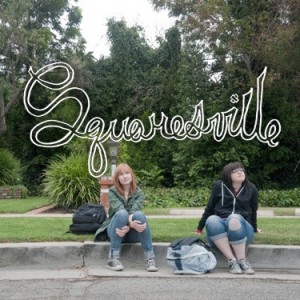“Fell in Love with a Song”: Squaresville and the Intimate Collective
I have a new favorite video. It’s not a fanvid and it’s not a TV credit sequence, nor a clip from a classic movie musical, (these would be the usual suspects for me), and it’s not even the Veronica Mars self-reflexive Kickstarter video (that’s another post!) but rather three minutes of intimate, personal address, from a fictional character. So this is to say that this isn’t the type of video that normally sticks with me, but this one stopped me in my tracks and has proven to have lasting power.
 This is the first of a series of “monolo7ues” attached to the web series Squaresville. Squaresville tells the story Zelda and Esther, two teenage girls longing for adventure in suburbia, feeling trapped by their small town and its small expectations. The series unfolds in vignettes about Zelda and Esther, eventually expanding to include other characters and their personal navigation of teenage/high school life. This video, coming to us at the beginning of season two of Squaresville, is the first instance where Zelda seemingly speaks directly to us in an intimate address. Perhaps it is this increased level of intimacy that draws me in. I have a feeling I’m going to watch this until I “burn it out” as Zelda says in the video, until “the magic fade(s) away,” until the video and “whatever it is about me that loves” this video “grow apart” and we don’t “understand each other anymore…”
This is the first of a series of “monolo7ues” attached to the web series Squaresville. Squaresville tells the story Zelda and Esther, two teenage girls longing for adventure in suburbia, feeling trapped by their small town and its small expectations. The series unfolds in vignettes about Zelda and Esther, eventually expanding to include other characters and their personal navigation of teenage/high school life. This video, coming to us at the beginning of season two of Squaresville, is the first instance where Zelda seemingly speaks directly to us in an intimate address. Perhaps it is this increased level of intimacy that draws me in. I have a feeling I’m going to watch this until I “burn it out” as Zelda says in the video, until “the magic fade(s) away,” until the video and “whatever it is about me that loves” this video “grow apart” and we don’t “understand each other anymore…”
I’m quoting from the video because that’s what the video about—it’s about our intimate dance with media, the elusive, ephemeral relationship we have with media, specifically in the case of this clip, with music. In it Zelda tells us about her favorite song, as she’s lying on the floor listening to it, and contemplates its temporary but intense power over her, or her shared power with it, her communion with it.
Perhaps as compelling to me as the video itself is the viewer response it garnered on YouTube. Commenter after commenter replied (and continue to do so) sharing their favorite song of the moment, the song they’re most likely to burn out soon. Some of them comment on the video clip as a representation, others don’t, some address Zelda playfully as if she were real, others address the actress who plays Zelda, Mary Kate Wiles, who speaks to the audience as herself in the video’s closing moments. Strangely, very few offer interpretation of their favored songs, rather content to just share in the collectively compiled list.
There’s a comfort and an ease in this collective list compiling that I find striking, especially within the interface of YouTube so infamous for its flame wars and thumbs up versus thumbs down level of discourse. Though this video’s use of film language may establish a more intimate feel than the series’ regular installments, Squaresville as a series has strategically worked to create a rapport with its viewers, establishing a sense of shared culture on shared platforms. In the closing moments of each episode, the actors entreat viewers to “Stay Square” and “Fight the Robots.” Squaresville also features #fanartfriday, where it retumbls fan art posted on Tumblr, thus encouraging and highlighting viewer participation and contribution on the same platform in a seemingly decentered flow of creativity. (Here’s a beautiful piece posted for fanartfriday featuring “Fell in Love with a Song.) Indeed, the Squaresville producers post the transcripts of the monolo7ues (including “Fell in Love with a Song”) and encourage viewers to share their own interpretations as mashups and artwork or as “response videos” on YouTube.
In a moment when television and film producers seek to recreate the web/audience relationship in the image of the broadcast TV industry (see Melanie Kohnen’s piece on Husbands,) web series like Squaresville strive to differentiate themselves by positioning themselves as within and part of the intimate-public space of a collective creative culture. In this case, it has resulted in a representation of fannish investment in media that is emotive yet not trapped in a stereotypical representation of incoherent fangirl squee. I don’t mean to further debase or to disavow fangirl squee, but there’s a quiet intimacy to this video that’s captivating, and makes me hit play day after day. That pile of papers that needs grading can wait another two minutes, fifty seconds.



We have recently turned to affect and emotions on all fronts in fan studies, positive, negative, the excess, the surplus of feelings seems to be at the center of what we do. I love the way you describe how the show effectively thematizes and performs this affect in what would offline be part of the DVD extras, right?
And by not naming the song, by it being 3:22 or 2:50 or *glances at ipod* 3:02, it becomes personalized at the same time as the feeling is universalized–among different fans and along our own historical timeline of fannish love…